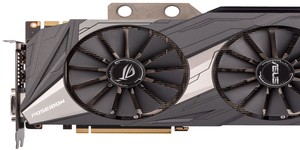Asus GeForce GTX 980 Ti Poseidon Review
Written by Matthew Lambert
October 5, 2015 | 09:40
Tags: #gtx-980-ti #hybrid-cooler #maxwell #water-cooling
Companies: #asus

Power Consumption (Idle and Gaming)
In order to get an idea of a GPU's power draw, we run our Unigine Valley 1.0 benchmark, which is our most GPU limited test. We use a watt meter to measure the maximum total system power draw during the test, and also take an idle reading at the Windows desktop (3,840 x 2,160).Power Consumption
Idle (Windows 8.1 Desktop) and Load (Unigine Valley 1.0)
- Sapphire Radeon R7 370 Nitro 4GB
- Gigabyte GeForce GTX 950 OC 2GB
- Palit GeForce GTX 960 Super JetStream 2GB
- Asus GeForce GTX 970 DirectCU Mini 4GB
- AMD Radeon R9 Nano 4GB
- Nvidia GeForce GTX 980 4GB
- Sapphire Radeon R9 380 Nitro 4GB
- Sapphire Radeon R9 390 Nitro 8GB
- Asus GeForce GTX 980 Ti Poseidon 6GB
- Sapphire Vapor-X R9 290X 4GB OC (reference clocks)
- Nvidia GeForce GTX 980 Ti 6GB
- AMD Radeon R9 Fury X 4GB
- Sapphire Radeon R9 Fury Tri-X 4GB
- Sapphire Radeon R9 390X Tri-X 8GB
-
-
129
-
246
-
-
-
130
-
252
-
-
-
127
-
267
-
-
-
128
-
290
-
-
-
134
-
343
-
-
-
130
-
358
-
-
-
137
-
367
-
-
-
137
-
406
-
-
-
132
-
409
-
-
-
140
-
419
-
-
-
133
-
422
-
-
-
140
-
445
-
-
-
140
-
475
-
-
-
139
-
493
-
0
100
200
300
400
500
System Power Draw in Watts (lower is better)
-
Idle
-
Load
Thermal Performance (Idle and Gaming)
Thermal output is also measured using Unigine's Valley 1.0 benchmark, as its DirectX 11 features will stress all parts of a modern GPU. The GPU is installed in a closed, but fairly well ventilated case (Corsair Graphite 760T) with HDD cages removed and the case fans at full speed. We leave all GPU fan profiles and settings as they come and leave the benchmark running for ten minutes so that temperatures plateau. We record the peak GPU temperature using GPU-Z, and present the data as the delta T (the difference between the GPU temperature and the ambient temperature in our labs). We also take an idle reading at the Windows desktop (3,840 x 2,160).Heat
Idle (Windows 8.1 Desktop) and Load (Unigine Valley 1.0)
- Asus GeForce GTX 980 Ti Poseidon 6GB (water-cooled)
- AMD Radeon R9 Fury X 4GB
- Sapphire Radeon R9 390 Nitro 8GB
- Gigabyte GeForce GTX 950 OC 2GB
- Palit GeForce GTX 960 Super JetStream 2GB
- Sapphire Radeon R9 380 Nitro 4GB
- Asus GeForce GTX 950 Strix 2GB
- Sapphire Radeon R7 370 Nitro 4GB
- Sapphire Vapor-X R9 290X 4GB OC (reference clocks)
- Asus GeForce GTX 970 DirectCU Mini 4GB
- Sapphire Radeon R9 Fury Tri-X 4GB
- Gigabyte GeForce GTX 980 Ti G1 Gaming 6GB
- Sapphire Radeon R9 390X Tri-X 8GB
- Asus GeForce GTX 980 Ti Poseidon 6GB
- MSI GeForce GTX 980 Ti Gaming 6GB
- AMD Radeon R9 Nano 4GB
- Asus GeForce GTX 980 Ti Strix 6GB
- Nvidia GeForce GTX 980 4GB
- Nvidia GeForce GTX 980 Ti 6GB
-
- 5
-
23
-
-
11
-
36
-
-
-
18
-
42
-
-
- 4
-
42
-
-
10
-
44
-
-
-
28
-
45
-
-
-
21
-
45
-
-
-
27
-
47
-
-
-
22
-
47
-
-
-
8
-
48
-
-
-
22
-
49
-
-
-
24
-
49
-
-
-
20
-
50
-
-
-
13
-
51
-
-
-
26
-
54
-
-
-
10
-
56
-
-
-
21
-
57
-
-
-
14
-
60
-
-
-
17
-
63
-
0
10
20
30
40
50
60
70
Delta T in °C (lower is better)
-
Idle
-
Load









Want to comment? Please log in.